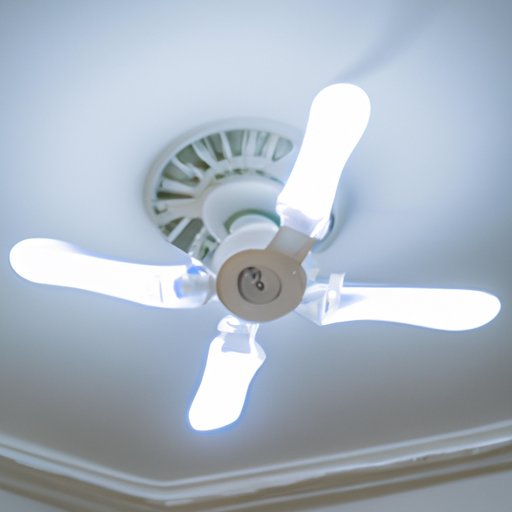Introduction
Ceiling fans are a great way to stay cool in the summer months, but did you know that they can also be used to help heat your home in the winter? The direction in which your ceiling fan is set during the winter months can have a significant impact on the overall efficiency of your heating system.
By understanding how to reverse the direction of your ceiling fan and setting it to turn clockwise in the winter, you can create an updraft that helps push warm air down from the ceiling and circulate it throughout the room. This simple change can help improve your home’s heating efficiency and reduce your energy bills.

Exploring the Benefits of Reversing Your Ceiling Fan Direction in the Winter
Reversing the direction of your ceiling fan in the winter can provide several benefits for your home and your wallet. Here are just a few of the ways that changing your ceiling fan direction can help you save money:
Improved Heating Efficiency
Setting your ceiling fan to rotate clockwise in the winter helps to create an updraft that pushes warm air down from the ceiling and circulates it throughout the room. This can help improve the efficiency of your heating system as the warm air is circulated more quickly throughout the space.
Lower Energy Bills
By improving the efficiency of your heating system, you can reduce the amount of energy that is needed to maintain a comfortable temperature in your home. This can lead to lower energy bills, as you will be using less energy to heat your home.

How to Reverse Your Ceiling Fan Direction for Maximum Energy Savings
Before you can set your ceiling fan to rotate clockwise in the winter, you need to first identify the fan direction switch. This switch is usually located on the side of the motor housing or near the canopy of your fan. Once you have identified the switch, you can follow these steps to reverse the direction of your fan:
- Turn off the power to your ceiling fan before attempting to make any changes.
- Rotate the switch to the opposite position (usually indicated by an arrow).
- Turn the power back on and confirm that the fan is rotating in the desired direction.

The Best Way to Set Your Ceiling Fan Direction During Winter
Once you have reversed the direction of your ceiling fan, you should also adjust the speed dial to the lowest setting. This will ensure that the fan is running at the optimal speed for creating an updraft and circulating warm air throughout the room.
Maximize Heating Efficiency with a Reversed Ceiling Fan
When set to rotate clockwise in the winter, a ceiling fan can help to create an updraft that pushes warm air down from the ceiling. This can help to increase air circulation in the room, which in turn can help to improve the efficiency of your heating system. Additionally, this increased air circulation can help to make the room feel more comfortable and reduce the amount of time needed to reach your desired temperature.
Should You Reverse Your Ceiling Fan Direction in the Winter?
Whether or not you should reverse the direction of your ceiling fan in the winter depends on several factors. If your home has high ceilings and you find that your heating system is struggling to keep the room warm, then reversing the direction of your fan could help to improve the efficiency of your system. On the other hand, if your home has low ceilings and you don’t have any issues with your heating system, then there may be no need to reverse the direction of your fan.
If you decide to reverse the direction of your fan, there are both pros and cons to consider. While reversing the direction of your fan can help to improve the efficiency of your heating system, it can also cause the fan to become noisier as it works harder to circulate air throughout the room. Additionally, reversing the direction of your fan can shorten its lifespan as it is working harder than usual.
Understanding the Benefits of Changing Ceiling Fan Direction in the Winter
Despite the potential drawbacks, reversing the direction of your ceiling fan in the winter can still provide several benefits. By increasing the circulation of warm air throughout the room, you can enjoy increased comfort levels while reducing your energy bills. Additionally, this simple change can help to improve the efficiency of your heating system, leading to further energy savings.
Conclusion
Reversing the direction of your ceiling fan in the winter can help to improve the efficiency of your heating system and reduce your energy bills. By setting your fan to rotate clockwise and adjusting the speed dial to the lowest setting, you can create an updraft that circulates warm air throughout the room and increases air circulation. This simple change can help to keep your home comfortable and energy-efficient during the cold winter months.


